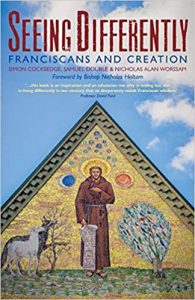
Canterbury Press Norwich, 2021-04-24
ISBN: 978-1786223005
Reviewed by Chris Holmes
_________________________________________________________________________________________________________
Hilfield Friary in rural Dorset has been home to Anglican Franciscans since 1921 and this book marks its centenary. For many years Hilfield was a place of hospitality for wayfaring men, of whom there were many in the 1920’s and 1930’s. It has evolved into a community where men and women, married and single, young and old shared the Brothers life, look after the land and care for guests. Today, Hilfield is a beacon of sustainable community living, inspired and guided by the Franciscan tradition.
There are three parts to this book, each by a different author. The first, by Simon Cocksedge, considers the life of St Francis in some detail, much of which is new to me. Simon shows how, for St. Francis, the whole of creation became the place of encounter with God: all creation was holy, nothing was trivial or worthless, and all things pointed beyond themselves to their Creator. The second part, by Nicholas Worssam, focuses on the Franciscan tradition, in particular on the generations which followed St Francis. Clare, Bonaventure and John Duns Scotus are reasonably familiar names but I was particularly interested in the lives and spirituality of the mystics Angela of Foligno and Jacapone.da Todi; I had not heard of these and the descriptions made me want to know much more, particularly their experience of the via negativa, the ‘negative way’ into the heart of union with God which I had not before associated with Franciscan theology.
Part three is by Samuel Double, who for many years was Guardian at Hilfield (Franciscans show their disdain for hierarchy by avoiding titles such as Prior) and who recently moved to the Franciscan house in Plaistow, East London. Brother Sam was deeply involved in Hilfield’s transformation to a place of practical and profound care for the creation; his contribution to the book is rooted in his experience at Hilfield and Plaistow and how it informs theological, moral and spiritual understandings as part of Christian living. This is heartfelt, deeply thoughtful and entertaining, particularly if one has experience of Hilfield (I have been a regular visitor since 2009.) As Brother Sam writes, for followers of Francis relationship is everything. Living a spirituality of creation centres on living in right relationship with all creation’ and ’leaving behind power and possessiveness.’
My only very slight niggle with this wonderful book is the ‘questions for reflection’ which appear at the end of each chapter. These are well meant but suggest a rather worthy ‘Lent course’ book. I finished each chapter with my mind buzzing and I felt the questions rather directed me away from my flow of thought; other readers may have a different response. This aside, Seeing Differently is a delightful book for our times, full of insight, inspiration and wisdom; non-Christians as well as Christians will find much in it of value.

